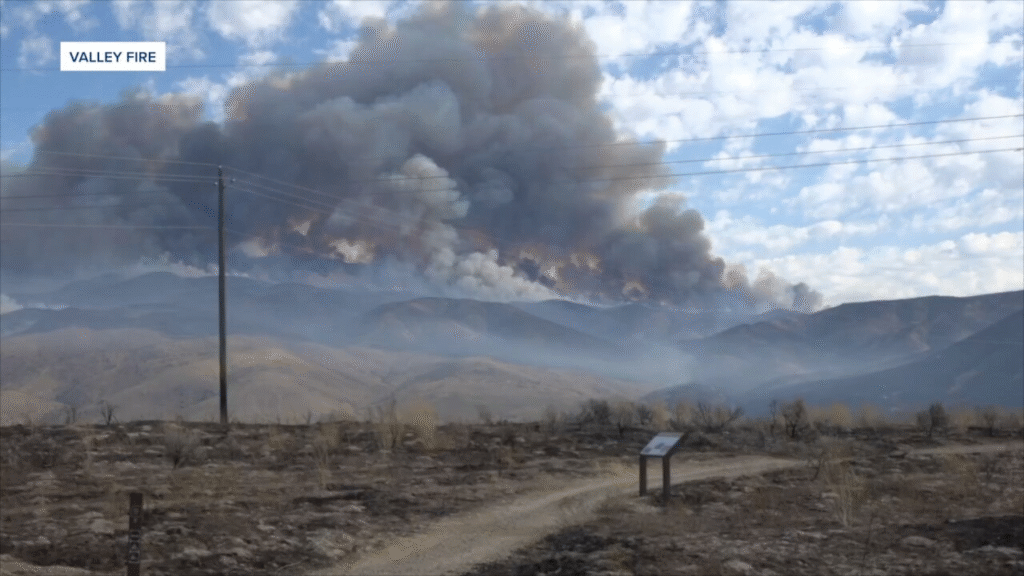Wildfire Risk Complicates Home Insurance: Wildfires have become a recurring nightmare in North Central Washington (NCW), where the scenic beauty of forests and valleys is now shadowed by the growing threat of uncontrollable flames. The 2014 Carlton Complex Fire alone scorched over 200,000 acres near Pateros, serving as a grim reminder of how quickly disaster can unfold. As climate change continues to escalate, wildland fires are expected to become more frequent and intense, creating long-term challenges not just for residents but also for the insurance industry.
For homeowners in NCW, securing a comprehensive home insurance policy has become increasingly difficult. Insurance providers, concerned with the financial risks associated with frequent fire damage claims, are either scaling back their coverage or completely pulling out of high-risk regions. This has left many residents in a difficult position, unable to find affordable or sufficient coverage for their homes and properties. These changes are affecting not only individual homeowners but also real estate markets and local economies dependent on stable housing infrastructure.
Life safety remains the top priority during wildfires, but once immediate threats are mitigated, the focus shifts quickly to property protection, asset recovery, and rebuilding. In such cases, insurance coverage becomes a lifeline. Unfortunately, in fire-prone areas like NCW, that lifeline is fraying. People are forced to look for alternative insurers, pay higher premiums, or resort to the state’s Fair Access to Insurance Requirements (FAIR) plans, which offer limited protection at higher costs.
Who Can Apply for Home Insurance in Wildfire-Prone Areas?
In North Central Washington, homeowners, renters, and property investors can still apply for insurance, but eligibility largely depends on the location of the property, its fire risk rating, and proximity to fire-fighting resources.
Applicants typically fall into these categories:
- Homeowners in high-risk zones (forest-adjacent or remote areas)
- Homebuyers seeking mortgage insurance
- Renters looking for personal property coverage
- Landowners with undeveloped or agricultural property
Some insurance companies now require home hardening measures, such as fire-resistant roofing and defensible space, to even consider an application.
Also read: American Lung Association Calls for Expanded Insurance: Coverage for Lung Cancer Screening
Home Insurance Fees in NCW Wildfire Zones
Insurance fees in wildfire-prone areas like NCW vary widely, depending on a property’s fire risk, construction materials, and mitigation measures. Here’s a breakdown of typical costs:
| Insurance Type | Average Annual Premium (High-Risk Areas) |
|---|---|
| Standard Homeowners | $2,000 – $4,500 |
| FAIR Plan (Basic Coverage) | $3,000 – $6,000 |
| Wildfire-Specific Riders | $500 – $2,000 (added to base policy) |
| Renters Insurance | $200 – $600 |
Insurers may charge higher deductibles, impose coverage exclusions (like landscaping damage), or limit coverage amounts in high-risk zones.
How to Use Home Insurance for Wildfire Protection
Your home insurance policy becomes crucial before, during, and after a wildfire incident. Here’s how:
- Pre-Fire: Ensure your policy includes wildfire coverage. Maintain updated home inventories and proof of upgrades.
- During Fire: Follow evacuation orders; keep your policy number handy. Most insurers offer 24/7 claims reporting.
- Post-Fire: File your claim as soon as it’s safe. Use your documentation (photos, receipts) to expedite compensation. WA State Office of the Insurance Commissioner
Policies may cover:
- Dwelling replacement
- Temporary housing (Loss of Use)
- Personal belongings
- Firefighting water damage
Benefits of Getting the Right Insurance
The right insurance policy offers more than just peace of mind. It provides:
- Financial Security – Covers repair or full replacement of homes and possessions.
- Temporary Relocation Coverage – Pays for hotel stays, food, and clothing during evacuation.
- Recovery Support – Access to repair contractors, inspectors, and adjusters.
- Reduced Out-of-Pocket Expenses – Helps avoid large unexpected costs after fire damage.
How to Apply for Wildfire-Aware Insurance in NCW
To apply for home insurance in wildfire-affected regions, follow these steps:
- Research Insurers – Use state insurance department tools to compare providers willing to cover NCW homes.
- Prepare Documents – Include property details, safety upgrades, recent renovations, and current photos.
- Consult an Agent – Work with a licensed agent familiar with high-risk insurance markets.
- Request a Wildfire Risk Assessment – Some companies require an inspection before approval.
- Apply Online or In Person – Complete the insurer’s application form, disclose fire mitigation measures, and wait for underwriting.
Important Dates to Remember
| Event | Date/Timeframe |
|---|---|
| Wildfire Season | May to October (peak: July-August) |
| Insurance Renewal Deadline | 30–60 days before policy expiration |
| FAIR Plan Application Windows | Year-round (approval in 10–30 days) |
| State Wildfire Preparedness Grants | Application opens: June 15, 2025 |

Disclaimer
This article provides general information based on current wildfire trends and home insurance regulations in North Central Washington. Policy terms and conditions vary between insurers. Please consult a licensed insurance provider or the Washington State Insurance Commissioner’s office for the most accurate and personalized advice. Rates mentioned are estimates and subject to change.
Wildfire Risk Complicates Home Insurance Conclusion
The increasing risk of wildfires in NCW has drastically reshaped the landscape of the home insurance market. As insurance companies reevaluate their exposure in high-risk zones, residents face rising costs, shrinking coverage, and complex eligibility requirements. However, these challenges should not discourage proactive homeowners from seeking adequate protection.
By understanding wildfire risks and insurance policies, residents can take steps to safeguard their homes, families, and investments. From hardening their homes to working with fire-smart communities, preparation is essential. It is also crucial to stay informed about state programs and federal aid that can supplement private insurance, especially in emergencies.
Furthermore, choosing the right insurer and upgrading home fire defenses can help reduce premiums and ensure continuous coverage. While it may take more effort to find a policy in NCW, the protection it offers far outweighs the risks of being uninsured in a fire-prone region.
In the face of growing natural disasters, community cooperation, timely action, and the right insurance plan can make all the difference between recovery and ruin. North Central Washington residents must stay alert, adapt, and act to secure their homes for an unpredictable future.
Wildfire Risk Complicates Home Insurance FAQs
1. Why is it so hard to get home insurance in wildfire-prone areas like NCW?
Due to the high frequency and cost of wildfire damage, many insurers consider regions like NCW too risky. The costs of rebuilding, payouts for claims, and increased regulatory scrutiny have led insurers to limit or deny coverage in these areas. This results in fewer options and higher premiums for homeowners.
2. What can I do to lower my insurance premiums in a wildfire-risk area?
You can reduce premiums by implementing fire-mitigation strategies such as using fire-resistant building materials, creating defensible space, installing sprinkler systems, and joining a Firewise USA community. Some insurers offer discounts for homes that pass a wildfire risk inspection.
3. What is the Washington FAIR Plan and who should use it?
The Washington FAIR Plan is a last-resort insurance program for property owners who cannot secure coverage from private insurers. It offers basic protection against fire and other risks, but often at higher premiums and with limited coverage. It’s designed for high-risk properties.
4. How soon should I file a claim after a wildfire damages my home?
You should file a claim as soon as it is safe to do so. Most insurers have a 24/7 claims hotline or online submission portal. Have your policy number, photos, videos, and a list of damaged items ready to streamline the process and avoid delays in compensation.
5. Are there any government grants or aid for wildfire protection in NCW?
Yes, the State of Washington and FEMA offer various grants for wildfire risk reduction, home hardening, and emergency preparedness. Programs like the Wildfire Ready Neighbors initiative provide financial and technical support for fire mitigation efforts. Check with Chelan County or the state’s emergency management office for updated opportunities.




One thought on “Wildfire Risk Complicates Home Insurance: Market in North Central Washington (NCW)”